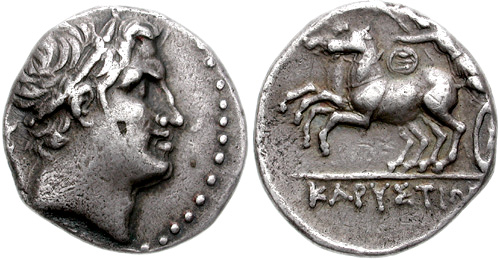H 155 - Carystus, silver, didrachms (240-208 BCE)
From SILVER
240 BCE - 208 BCE Silver 1,228 kg
Description
| ObverseInscription or printing placed on the obverse.: | Diademed male head right. |
| ReverseInscription or printing placed on the reverse.: | KAPY, KAPYΣ ou KAPYΣΤΙΩΝ (Greek).Nike, holding long palm, driving galloping biga left, trident in wreath above horses. |
Mint and issuing power
| MintIdentifies the place of manufacture or issue of a numismatic object.: | Carystus | Ancient regionAncient region.: | Euboea | Modern countryModern country: Greece | AuthorityIdentifies the issuing power. The authority can be "pretended" when the name or the portrait of X is on the coin but he/she was not the issuing power. It can also be "uncertain" when there is no mention of X on the coin but he/she was the issuing power according to the historical sources: |
Chronology
| FromIdentifies the initial date in a range assigned in a numismatic context. | 240 BCE | toIdentifies the final date in a range assigned in a numismatic context.. | 208 BCE | PeriodTime period of the numismatic object.: Hellenistic 323-30 BC |
Physical description
| MetalThe physical material (usually metal) from which an object is made.: | Silver |
Median weightMedian of the weights of numismatic objects (in grams). in grams | 7.00 | DenominationTerm indicating the value of a numismatic object. Examples: tetradrachm, chalkous, denarius.: | didrachm |
StandardStandard.: |
Image

H155 Carystos didrachm.jpeg [1]
References
| Die study referencePublication of the study: | Wallace 19681Wallace 1968, p. 201-209, pl. 26. | ||
| Coin series referenceReference to coin series study: | RQEMH2RQEMH, n° 155 | ||
Obverse dies distribution
| FrequencyFrequency of specimen in distribution. ᵖ | Number of obversesNumber of obverse dies. ᵖ (o) | % (o) | Number of coinsNumber of coins. (n) | % (n) | Die nameName(s) of the die(s). |
| 1 | 1 | 12.5 | 1 | 2.33 | 4 |
| 2 | 1 | 12.5 | 2 | 4.65 | 2 |
| 3 | 2 | 25 | 6 | 13.95 | 1, 5 |
| 5 | 1 | 12.5 | 5 | 11.63 | 7 |
| 6 | 1 | 12.5 | 6 | 13.95 | 6 |
| 10 | 1 | 12.5 | 10 | 23.26 | 3 |
| 13 | 1 | 12.5 | 13 | 30.23 | 8 |
| Total | 8 of 8 | 100 | 43 of 43 | 100 |
Reverse dies distribution
no distribution is available
Quantification
| Number of obversesNumber of obverse dies. ᵖ (o) | 8 | Number of singletons (o1)The number of singleton coins. ᵖ | 1 |
| Number of reverse diesNumber of reverse dies. (r) | 12 | Number of coinsNumber of coins. (n) | 43 |
| Coins per obverse dieNumber of coins per obverse die. (n/o) | 5.38 | Coins per reverse dieNumber of coins per reverse die. (n/r) | 3.58 |
| Reverse per obverse ratioRatio of obverse dies divided by reverse dies. (r/o) | 1.5 | Percentage of singletons (o1)number of coins (n) divided by the number of singletons (o1) ᵖ | 12.5 % |
| Original number of dies (O) (Carter 1983 formula)The estimation of the number of coins according to Carter 1983 ᵖ | 8.77 | Coins struck if 20,000 as average productivity per dieCoins made if the average productivity for obverses (according to Carter) is 20,000. ᵖ | 175,400 |
| Original number of dies (O) (Esty 2011 formula)The estimation of the number of coins according to the singleton formula in Esty 2011 ᵖ (O) | 9.83 | Survival rate if 20,000 as average productivity per dieSurvival rate if average productivity is 20,000. ᵖ | 0.00025 |
| Coverage (o = % of O) (Esty 1984 formula)Esty 1984 - coverage (% of O) ᵖ (o = % of O) | 97.67% | Die productivity if survival rate 1/2,000Average productivity if survival rate is 1/2,000. ᵖ | 9,806.16 |
| Weight of silver (in kg) if 20,000 coins per die (O = Carter formula)Carter 1983 * Median weight * 20000 (*10 if gold or electrum) ᵖ | 1,228 kg <br /> 1,228 kg | Die productivity if survival rate 1/5,000Average productivity if survival rate is 1/5,000. ᵖ | 24,515.39 |
Remarks
Most likely one single workstation